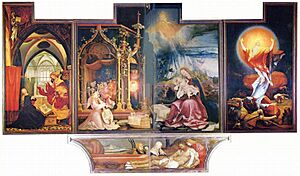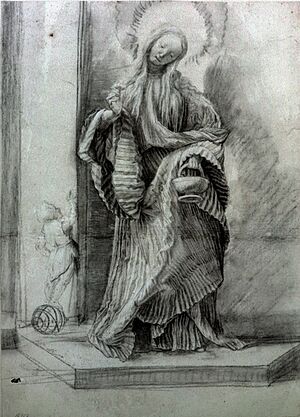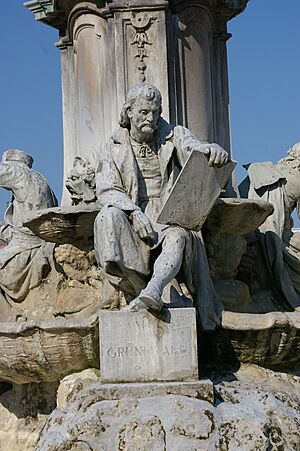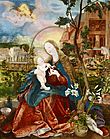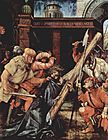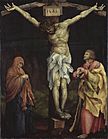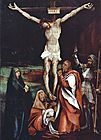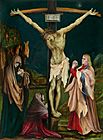Matthias Grünewald facts for kids
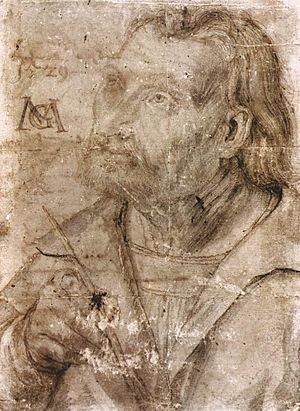
Matthias Grünewald (born around 1470 – died August 31, 1528) was a famous German Renaissance painter. He mostly painted religious art. Unlike many artists of his time, he kept a style similar to older medieval art. His first name is sometimes spelled Mathis. His last name can also be Gothart or Neithardt.
Only ten of his paintings and thirty-five drawings still exist today. All of them are religious. Many other works were lost, some even at sea during a war. For a long time, people didn't know much about him. In the late 1800s, he became more well-known. Some of his paintings were even thought to be by Albrecht Dürer, another famous artist.
His biggest and most famous artwork is the Isenheim Altarpiece. He created it between 1512 and 1516.
Contents
Life of Matthias Grünewald
Matthias Grünewald was well-known during his lifetime. However, we don't know many details about his life. The first information about him comes from a German art historian named Joachim von Sandrart. He wrote that around 1505, Grünewald worked on an altarpiece by Albrecht Dürer in Frankfurt. This kind of work was often done by younger artists. This suggests he was born around 1475.
Sandrart also wrote that Grünewald had an apprentice named Hans Grimmer. Grimmer became famous, but most of his works were lost. Sandrart described Grünewald as a quiet and thoughtful person. He also said Grünewald had an unhappy marriage.
More recent studies have found more facts about Grünewald's life. In 1511, he became the court artist for the Archbishop of Mainz. He also worked for the next archbishop. Around 1510, he moved to Frankfurt. He bought a house there and married a woman named Anna. She was about 18 years old. Their marriage was not happy. In 1523, Anna became very ill and was cared for in a special place.
From 1512 to 1515, he worked on the Isenheim Altarpiece. He seemed to work with another artist named Mathis. Grünewald left Isenheim quickly after this project. He returned to Frankfurt. He might not have been fully paid for the altarpiece, as he seemed to be poor afterward. In 1527, he began working for a rich family. He likely died in 1528, though some sources say 1532.
For many years, there was confusion about his life. Some thought Grünewald and his partner Mathis were the same person. This idea is now mostly considered incorrect.
Famous Artworks
Grünewald's most famous work is the Isenheim Altarpiece. He finished it in 1515. It is now in a museum in Colmar, France. This altarpiece is very special. It has nine images on twelve panels. It can be opened in different ways to show three different scenes. These scenes could be changed depending on the time of year or special events.
When the outer panels are closed, you see a painting of the Crucifixion. On the sides are Saint Sebastian and Saint Anthony. Below them is a scene of Jesus being placed in his tomb.
When the first set of panels is opened, you see different scenes. These include the Annunciation (when an angel tells Mary she will have a baby), an Angelic Concert, Mary bathing Christ, and the Resurrection (Jesus rising from the dead).
The third view shows a carved wooden altarpiece by another artist. On its sides, Grünewald painted the Temptation of Saint Anthony and Anthony's visit to Saint Paul. This altarpiece is very large. It is 2.65 meters (about 8.7 feet) tall and over 5 meters (about 16.4 feet) wide when fully open.
Most of Grünewald's other works are in Germany. There is a small Crucifixion painting in Washington, D.C. and another in Basel, Switzerland. Around 1510, he painted four saints for another altarpiece by Albrecht Dürer. Dürer's part of that altarpiece was destroyed, but Grünewald's paintings of the saints survived. They are now in art galleries in Frankfurt and Karlsruhe.
Other works include the Tauberbischofsheim altarpiece and The Establishment of the Santa Maria Maggiore in Rome. A large painting of Saint Erasmus and Saint Maurice is in Munich. It was likely part of a bigger altarpiece that is now lost. Grünewald painted four powerful Crucifixion scenes that still exist. His paintings are known for their strong feelings, bright colors, and how he shows light. His style is very different from Dürer's.
Grünewald's Reputation
Few writers from Grünewald's time mentioned him. One writer, Philip Melanchthon, described his style as "moderate." This is surprising, as his art is very dramatic. It's unclear which paintings Melanchthon was looking at. By the late 1500s, many people thought the Isenheim Altarpiece was painted by Dürer.
In the late 1800s, Grünewald was "rediscovered." He became very popular, especially in Germany. People liked the strong emotions and unique style of the Isenheim Altarpiece. Writers like Joris-Karl Huysmans wrote about his art. Grünewald also gained admiration from people who supported peasants. This was because he seemed to sympathize with them during the German Peasants' War.
The composer Paul Hindemith created an opera in 1938 called Mathis der Maler. It is based on Grünewald's life during the German Peasants' War. A scene in the opera even shows parts of the Isenheim Altarpiece.
The author Elias Canetti wrote his novel Auto-da-Fé while surrounded by pictures of the Isenheim Altarpiece. German author W. G. Sebald also wrote about Grünewald in his book After Nature. He used Grünewald's ideas and the Isenheim Altarpiece to talk about the world. The altarpiece is also in Sebald's novel The Emigrants.
Veneration
The Lutheran Church honors Matthias Grünewald as an artist and saint. He is remembered on April 6, along with Dürer and Cranach.
Gallery
-
Crucifixion in the National Gallery of Art, Washington.
See also
 In Spanish: Matthias Grünewald para niños
In Spanish: Matthias Grünewald para niños


